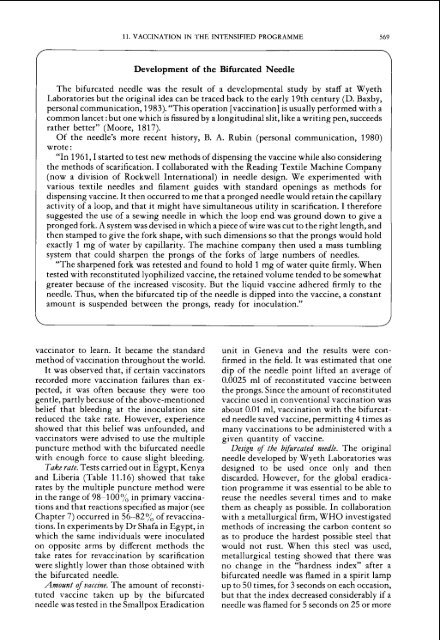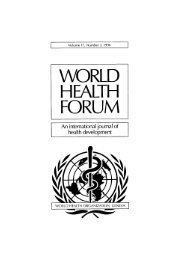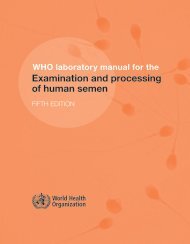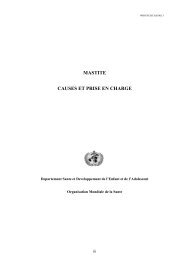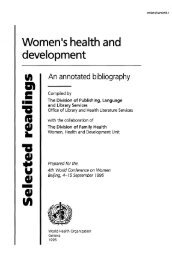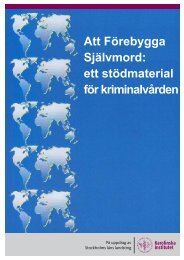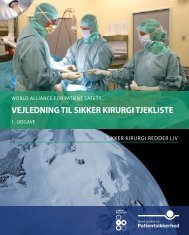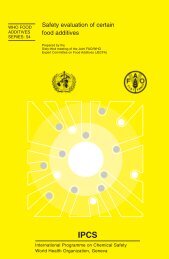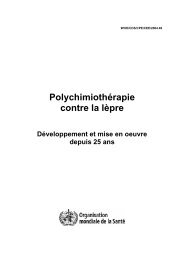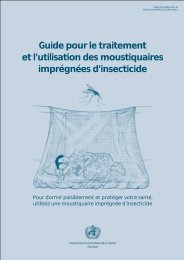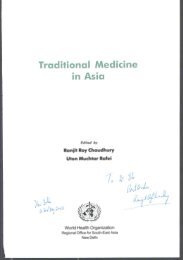smallpox vaccine and vaccination in the intensified ... - libdoc.who.int
smallpox vaccine and vaccination in the intensified ... - libdoc.who.int
smallpox vaccine and vaccination in the intensified ... - libdoc.who.int
Create successful ePaper yourself
Turn your PDF publications into a flip-book with our unique Google optimized e-Paper software.
11. VACCINATION IN THE INTENSIFIED PROGRAMME 569<br />
Development of <strong>the</strong> Bifurcated Needle<br />
The bifurcated needle was <strong>the</strong> result of a developmental study by staff at Wyeth<br />
Laboratories but <strong>the</strong> orig<strong>in</strong>al idea can be traced back to <strong>the</strong> early 19th century (D. Baxby,<br />
personal communicatio~, 1983). "This operation [<strong>vacc<strong>in</strong>ation</strong>] is usually perfdr&ed with-a<br />
common lancet :but one which is fissured by a longitud<strong>in</strong>al slit, like a writ<strong>in</strong>g pen, succeeds<br />
ra<strong>the</strong>r better" (Moore, 181 7).<br />
Of <strong>the</strong> needle's more recent history, B. A. Rub<strong>in</strong> (personal communication, 1980)<br />
wrote :<br />
"In 1961, I started to test new methods of dispens<strong>in</strong>g <strong>the</strong> <strong>vacc<strong>in</strong>e</strong> while also consider<strong>in</strong>g<br />
<strong>the</strong> methods of scarification. I collaborated with <strong>the</strong> Read<strong>in</strong>g Textile Mach<strong>in</strong>e Com~anv<br />
0 I I<br />
(now a division of Rockwell International) <strong>in</strong> needle design. We experimented with<br />
various textile needles <strong>and</strong> filament guides with st<strong>and</strong>ard open<strong>in</strong>gs as methods for<br />
dispens<strong>in</strong>g <strong>vacc<strong>in</strong>e</strong>. It <strong>the</strong>n occurred to me that a pronged needle would reta<strong>in</strong> <strong>the</strong> capillary<br />
activity of a loop, <strong>and</strong> that it might have simultaneous utility <strong>in</strong> scarification. I <strong>the</strong>refore<br />
suggested <strong>the</strong> use of a sew<strong>in</strong>g needle <strong>in</strong> which <strong>the</strong> loop end was ground down to give a<br />
pronged fork. A system was devised <strong>in</strong> which a piece of wire was cut to <strong>the</strong> right length, <strong>and</strong><br />
<strong>the</strong>n stamped to give <strong>the</strong> fork shape, with such dimensions so that <strong>the</strong> prongs would hold<br />
exactly 1 mg of water by capillarity. The mach<strong>in</strong>e company <strong>the</strong>n used a mass tumbl<strong>in</strong>g<br />
system that could sharpen <strong>the</strong> prongs of <strong>the</strong> forks of large numbers of needles.<br />
"The sharpened fork was retested <strong>and</strong> found to hold 1 mg of water quite firmly. When<br />
tested with reconstituted lyophilized <strong>vacc<strong>in</strong>e</strong>, <strong>the</strong> reta<strong>in</strong>ed volume tended to be somewhat<br />
greater because of <strong>the</strong> <strong>in</strong>creased viscosity. But <strong>the</strong> liquid <strong>vacc<strong>in</strong>e</strong> adhered firmly to <strong>the</strong><br />
needle. Thus, when <strong>the</strong> bifurcated tip of <strong>the</strong> needle is dipped <strong>in</strong>to <strong>the</strong> <strong>vacc<strong>in</strong>e</strong>, a constant<br />
amount is suspended between <strong>the</strong> prongs, ready for <strong>in</strong>oculation."<br />
vacc<strong>in</strong>ator to learn. It became <strong>the</strong> st<strong>and</strong>ard<br />
method of <strong>vacc<strong>in</strong>ation</strong> throughout <strong>the</strong> world.<br />
It was observed that, if certa<strong>in</strong> vacc<strong>in</strong>ators<br />
recorded more <strong>vacc<strong>in</strong>ation</strong> failures than expected,<br />
it was often because <strong>the</strong>y were too<br />
gentle, partly because of <strong>the</strong> above-mentioned<br />
belief that bleed<strong>in</strong>g at <strong>the</strong> <strong>in</strong>oculation site<br />
reduced <strong>the</strong> take rate. However, experience<br />
showed that this belief was unfounded, <strong>and</strong><br />
vacc<strong>in</strong>ators were advised to use <strong>the</strong> multiple<br />
puncture method with <strong>the</strong> bifurcated needle<br />
with enough force to cause slight bleed<strong>in</strong>g.<br />
Take rate. Tests carried out <strong>in</strong> Egypt, Kenya<br />
<strong>and</strong> Liberia (Table 11.16) showed that take<br />
rates by <strong>the</strong> multiple puncture method were<br />
<strong>in</strong> <strong>the</strong> range of 98-100% <strong>in</strong> primary <strong>vacc<strong>in</strong>ation</strong>s<br />
<strong>and</strong> that reactions specified as major (see<br />
Chapter 7) occurred <strong>in</strong> 56-82% of re<strong>vacc<strong>in</strong>ation</strong>s.<br />
In experiments by Dr Shafa <strong>in</strong> Egypt, <strong>in</strong><br />
which <strong>the</strong> same <strong>in</strong>dividuals were <strong>in</strong>oculated<br />
on opposite arms by different methods <strong>the</strong><br />
take rates for re<strong>vacc<strong>in</strong>ation</strong> by scarification<br />
were slightly lower than those obta<strong>in</strong>ed with<br />
<strong>the</strong> bifurcated needle.<br />
Amount of <strong>vacc<strong>in</strong>e</strong>. The amount of reconstituted<br />
<strong>vacc<strong>in</strong>e</strong> taken up by <strong>the</strong> bifurcated<br />
needle was tested <strong>in</strong> <strong>the</strong> ~mall~ox<br />
unit <strong>in</strong> Geneva <strong>and</strong> <strong>the</strong> results were confirmed<br />
<strong>in</strong> <strong>the</strong> field. It was estimated that one<br />
dip of <strong>the</strong> needle po<strong>in</strong>t lifted an average of<br />
0.0025 m1 of reconstituted <strong>vacc<strong>in</strong>e</strong> between<br />
<strong>the</strong> prongs. S<strong>in</strong>ce <strong>the</strong> amount of reconstituted<br />
<strong>vacc<strong>in</strong>e</strong> used <strong>in</strong> conventional <strong>vacc<strong>in</strong>ation</strong> was<br />
about 0.01 ml, <strong>vacc<strong>in</strong>ation</strong> with <strong>the</strong> bifurcated<br />
needle saved <strong>vacc<strong>in</strong>e</strong>, permitt<strong>in</strong>g 4 times as<br />
many <strong>vacc<strong>in</strong>ation</strong>s to be adm<strong>in</strong>istered with a<br />
given quantity of <strong>vacc<strong>in</strong>e</strong>.<br />
Design of <strong>the</strong> b$urcated needle. The orig<strong>in</strong>al<br />
needle developed by Wyeth Laboratories was<br />
designed to be used once only <strong>and</strong> <strong>the</strong>n<br />
discarded. However, for <strong>the</strong> global eradication<br />
programme it was essential to be able to<br />
reuse <strong>the</strong> needles several times <strong>and</strong> to make<br />
<strong>the</strong>m as cheaply as possible. In collaboration<br />
with a metallurgical firm, WHO <strong>in</strong>vestigated<br />
methods of <strong>in</strong>creas<strong>in</strong>g <strong>the</strong> carbon content so<br />
as to produce <strong>the</strong> hardest possible steel that<br />
would not rust. When this steel was used,<br />
metallurgical test<strong>in</strong>g showed that <strong>the</strong>re was<br />
no change <strong>in</strong> <strong>the</strong> "hardness <strong>in</strong>dex" after a<br />
bifurcated needle was flamed <strong>in</strong> a spirit lamp<br />
up to 50 times, for 3 seconds on each occasion,<br />
but that <strong>the</strong> <strong>in</strong>dex decreased considerably if a<br />
Eradication needle was flamed for 5 seconds on 25 or more


